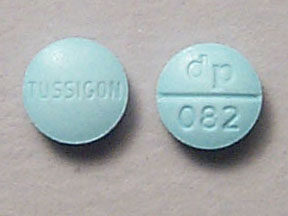Tussigon and Alcohol/Food Interactions
There are 2 alcohol/food/lifestyle interactions with Tussigon (homatropine / hydrocodone).
Hydrocodone Food/Lifestyle
Major Food Interaction
GENERALLY AVOID: Alcohol may potentiate the central nervous system (CNS) depressant effects of opioid analgesics including hydrocodone. Concomitant use may result in additive CNS depression and impairment of judgment, thinking, and psychomotor skills. In more severe cases, hypotension, respiratory depression, profound sedation, coma, or even death may occur.
GENERALLY AVOID: Consumption of alcohol while taking some sustained-release formulations of hydrocodone may cause rapid release of the drug, resulting in high systemic levels of hydrocodone that may be potentially lethal. Alcohol apparently can disrupt the release mechanism of some sustained-release formulations. In study subjects, the rate of absorption of hydrocodone from an extended-release formulation was found to be affected by coadministration with 40% alcohol in the fasted state, as demonstrated by an average 2.4-fold (up to 3.9-fold in one subject) increase in hydrocodone peak plasma concentration and a decrease in the time to peak concentration. Alcohol also increased the extent of absorption by an average of 1.2-fold (up to 1.7-fold in one subject).
GENERALLY AVOID: Grapefruit juice may increase the plasma concentrations of hydrocodone. The proposed mechanism is inhibition of CYP450 3A4-mediated metabolism of hydrocodone by certain compounds present in grapefruit. Increased hydrocodone concentrations could conceivably increase or prolong adverse drug effects and may cause potentially fatal respiratory depression.
MANAGEMENT: Patients taking sustained-release formulations of hydrocodone should not consume alcohol or use medications that contain alcohol. In general, potent narcotics such as hydrocodone should not be combined with alcohol. Patients should also avoid consumption of grapefruit or grapefruit juice during treatment with hydrocodone.
References (1)
- (2013) "Product Information. Zohydro ER (hydrocodone)." Zogenix, Inc
Switch to consumer interaction data
Homatropine High Blood Pressure (Hypertension)
Minor Potential Hazard, Low plausibility
anticholinergics - hypertension
Cardiovascular effects of anticholinergics may exacerbate hypertension. Therapy with anticholinergic agents should be administered cautiously in patients with hypertension.
References (7)
- (2002) "Product Information. Benadryl (diphenhydramine)." Parke-Davis
- (2001) "Product Information. Antivert (meclizine)." Roerig Division
- (2001) "Product Information. Marezine (cyclizine)." Glaxo Wellcome
- Valentin N, Staffeldt H, Kyst A (1984) "Effect of i.v. atropine on cardiac rhythm, heart rate, blood pressure and airway secretion during isoflurane anaesthesia." Acta Anaesthesiol Scand, 28, p. 621-4
- (2022) "Product Information. Atropine Sulfate (atropine)." ESI Lederle Generics
- (2001) "Product Information. Artane (trihexyphenidyl)." Lederle Laboratories
- (2002) "Product Information. Atropisol (atropine ophthalmic)." Ciba Vision Ophthalmics
Switch to consumer interaction data
Tussigon drug interactions
There are 661 drug interactions with Tussigon (homatropine / hydrocodone).
Tussigon disease interactions
There are 33 disease interactions with Tussigon (homatropine / hydrocodone) which include:
- autonomic neuropathy
- GI obstruction
- glaucoma
- obstructive uropathy
- reactive airway diseases
- myasthenia gravis
- infectious diarrhea
- impaired GI motility
- infectious diarrhea
- prematurity
- acute alcohol intoxication
- drug dependence
- hypotension
- intracranial pressure
- respiratory depression
- gastrointestinal obstruction
- cardiac disease
- tachycardia
- coronary artery disease
- gastric ulcer
- gastroesophageal reflux
- ulcerative colitis
- adrenal insufficiency
- liver disease
- renal dysfunction
- seizure disorders
- urinary retention
- arrhythmias
- biliary tract disease
- hypertension
- hyperthyroidism
- diarrhea
- fever
More about Tussigon (homatropine / hydrocodone)
- Tussigon consumer information
- Check interactions
- Compare alternatives
- Drug images
- Side effects
- Dosage information
- During pregnancy
- Drug class: upper respiratory combinations
Related treatment guides
Drug Interaction Classification
| Highly clinically significant. Avoid combinations; the risk of the interaction outweighs the benefit. | |
| Moderately clinically significant. Usually avoid combinations; use it only under special circumstances. | |
| Minimally clinically significant. Minimize risk; assess risk and consider an alternative drug, take steps to circumvent the interaction risk and/or institute a monitoring plan. | |
| No interaction information available. |
See also:
Further information
Always consult your healthcare provider to ensure the information displayed on this page applies to your personal circumstances.


